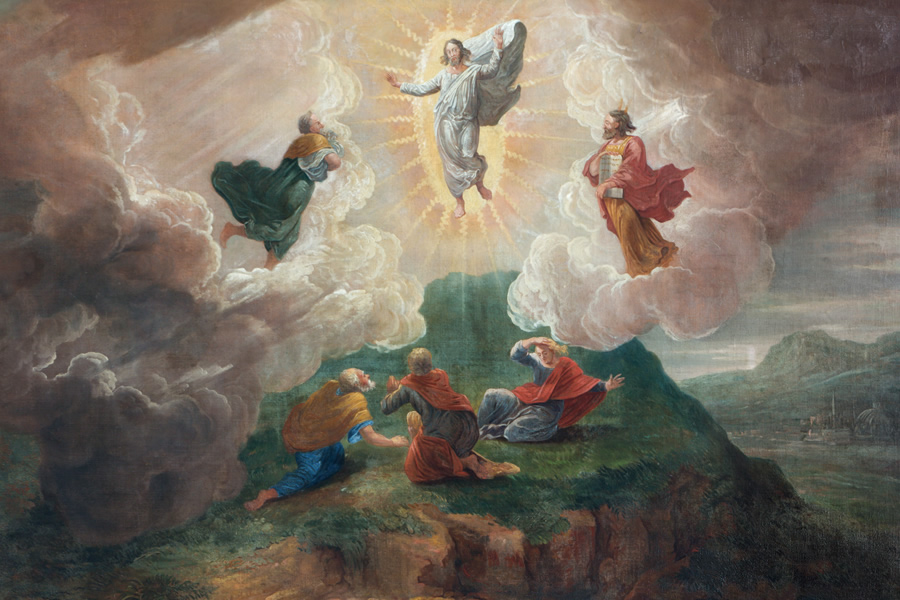
The Transfiguration of the Lord
by Rev. Gabriel Baltes, O.S.B. | 08/03/2025 | A Message from Our PastorDear Parishioners,
Every year on August 6, the church celebrates the feast of the Transfiguration of the Lord. The event of the Lord’s transfiguration is recorded in all four gospels, and one of these accounts is always proclaimed on the Second Sunday of Lent. August 6th however, is the liturgical commemoration of this highly significant moment in the life of Jesus and the select apostles Peter, James and John who are led, by Jesus, to Mount Tabor. This mountain is about five miles southeast of Nazareth and rises to the peak of 1,650 feet. Tabor was consistently regarded as a holy mountain by a number of religious traditions including that of Israel.
In the ancient world all mountains were understood to have a sacral character because they rose from the earth coming close to heaven where time came close to eternity. Mt. Tabor is the site we read about in the Book of Genesis where the priest-king Melchizedek, who is described as existing before all time, comes forward to bless Abraham with gifts of bread and wine. Christians will later see in this mysterious f igure a foreshadowing of Jesus who gives the Eucharist to the church.
In Luke’s account of the Transfiguration, once Jesus and the three apostles arrive at the mountaintop of Tabor, Jesus becomes enwrapped in prayer while his face changes in appearance and his clothes become dazzling white. Then the Old Testament figures of Moses, representing the Law, and Elijah, representing the prophets, appear and begin conversing with Jesus.
Meanwhile the apostles fall asleep. (This will not be the last time these three fall asleep when something of great significance is happening to Jesus.) When they suddenly awake, Peter wants to build three tents for Jesus, Moses and Elijah so that this experience can become permanent. While he was making this suggestion, the text reads that a cloud enveloped them all creating a deep great sense of wonder and fear. From the cloud God’s voice is heard saying, This is my chosen Son: listen to him. But moments after this divine declaration that identified Jesus’ unique relationship with the Father, the vision ceases and the three are left alone with Jesus who instructs them not to tell anyone what they had just seen.
Various interpretations are given by theologians as to what the Transfiguration means and what it was intended to do for the apostles. A common explanation is that it gave the apostles a glimpse of Jesus’ true identity as the Son of God. This was meant to strengthen them for another mountaintop experience when Jesus would be nailed to the cross in his ultimate gift of self-sacrifice. If the apostles could realize this identity of Jesus they would be better equipped to “get through” the horror of the crucifixion.
The Transfiguration offers us a similar invitation. It invites us to see God’s presence which is always available to us at any moment and in any place. All we must do is stay awake and be open to the surprising ways that God can manifest God’s life. This is sometimes referred to as having a mystical experience when a person, usually in an unexpected way and in an unexpected place, is suddenly overwhelmed with the realization of God’s immanence that brings with it a profound connection to all people and to all creation.
This happened to the acclaimed spiritual writer and Trappist monk, Thomas Merton. In 1958, while walking at the corner of Walnut and Fourth Street in Louisville, Kentucky, he suddenly became aware that all the people who surrounded him at that moment on that busy street corner were no longer strangers, but brothers and sisters with whom he shared a divine existence. This mystical moment forever changed his life and reinforced, in a most visceral way, all that the Christian (and monastic) life was meant to teach him.
This was Thomas Merton’s Transfiguration experience. Like the apostles who were privileged to behold the Transfiguration of Jesus on Mt. Tabor, it was not a place where he could build a tent and reside permanently. It was a fleeting moment of intense grace that sent him back to the mundane world of his monastery in Kentucky where he would live out the communion he discovered.
We may sometimes feel that these esoteric Transfiguration experiences are reserved for “special” people like Peter, James, John and Thomas Merton. I would disagree. I am inclined to believe that these types of experiences happen to all of us more frequently than we realize or want to admit. We may not always have the vocabulary to describe them, and we may even feel a certain awe or fear that leads us to not speak about them, but they punctuate our lives and serve as portals of glory that reveal our true identity as God’s beloved sons and daughters.
Happy Transfiguration. Fr. Gabriel, O.S.B.
BACK TO LIST